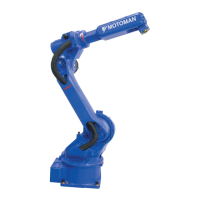6-24
168542-1CD
168542-1CD
MLX200 Software and
Operations
6 Conveyor Tracking
6.7 Developing a Conveyor Tracking Application
Another example scenario involves a robot is picking parts off of one
conveyor and placing them onto a tracked part on another conveyor. For
example, consider the application shown in Fig.6-27 "One Robot with Two
Conveyors Example". In this example, parts are being tracked and picked
on Conveyor 0 and placed onto a tracked tray on Conveyor 1. After four
parts have been placed on the tray, the robot will remove that tray from its
queue and start placing parts on the next tray. To do this, the Conveyor
Sync Stop command on Conveyor 1 would be called with KeepInQueue=1
and NewRobotQueue=0. This tells the system to stop tracking that
conveyor but keep the part in the queue for the next time. After the tray is
full, a Conveyor Sync Stop with KeepinQueue=0 could be called to flush
the object.
Fig. 6-27: One Robot with Two Conveyors Example
6.7.2.4 Conveyor Tracking Programming Pitfalls
The following sections describe some basic pitfalls that can come from
programming Conveyor Tracking applications.
DELAY AFTER CHECKING MAXSTARTPOSITION
The start position of an object is recorded and checked against the
MaxStartPosition when the MLxRobotConvSyncStart command is
executed. If there is a delay between this call and the first motion (as in
Fig.6-28 "Basic Conveyor Program Structure"), a part may move beyond
the MaxStartPosition without an error occurring. For this case, the part
might not be reachable and an axis limit might be exceeded.

